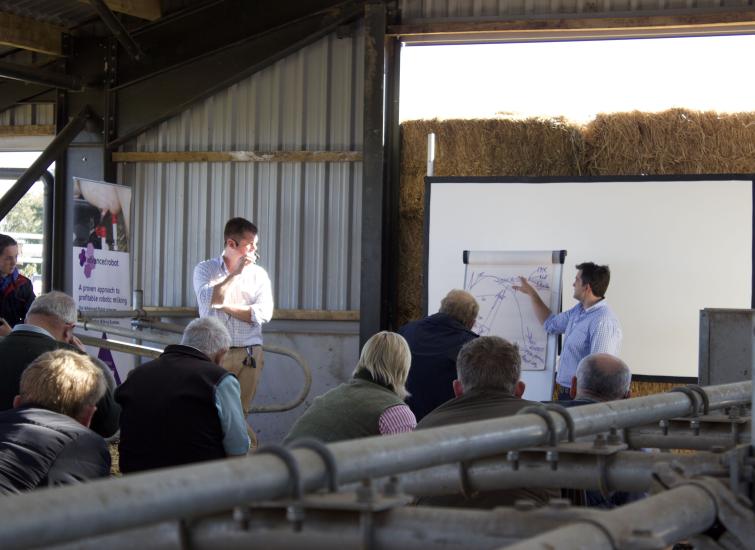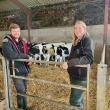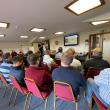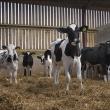Attention to detail drives robot productivity
Eoghan Mullery reports on a series of farm meetings from our Advanced Robot Programme

“Driving visits is the key to productivity in robot systems.” With that focus, we recently organised workshops in Cheshire and Cumbria with guest speakers - Dr Adam Geiger from the Zinpro Corporation and Dr Nick Bell who specialises in lameness prevention. As well as myself, Ruminant Nutritionist from our Robot Division.
On the second of these meetings we visited the Harrison family at Dundraw Farm, Wigton, Cumbria where we introduced the Advanced Robot concept which balances robot settings, nutrition and farm management. While no two robot systems are identical, we used the farm as a case study demonstrating clear messages about management to increase visits. On a typical system the target should be a minimum of three visits per day; robotic technology should comfortably match or exceed a three times a day milking system.
Feeding Balance
How we manage the feeding around robots can have a big impact on visits, so getting the balance between the TMR and the feed through the robot is crucial. If we set the outside diet too low, it will be difficult for high yielders to achieve adequate total daily intakes. Equally if it is too high, we can make stale cows lazy with visits dropping away. Furthermore, setting the outside ration level depends on a number of issues and this year forage quantity and quality will be major considerations.
Another crucial question is where to set the initial level of concentrates fed through the robot. A major consideration is that cows milked through robotic systems hit peak yields sooner than parlour milked cows at around 40 days. In our experience many systems set the initial available feed too low. In parlour systems the starting rate is commonly 2-3kg/milking so 6kg/day, but in robots we often see a start rate of 3kg/day.
If we need to feed to an early peak and can bets practice is to increase at 1kg/day if you start too low you will be unable to build up quickly enough. For a 35 ltr herd average we would be working on starting cows on 4-6kg/day building to 11kg on day 14 and 13kg by day 21. Building to a minimum of 12kg can be achieved as early as 14 days in milk or up to 21 days on milk depending on limiting factors such as cow health particularly lameness. These totals will be similar to conventional milked herds but by being fed over more visits we can influence rumen health.
The key to success is to consider the balance between health, nutrition and robot settings to achieve your goals.
Foot Health
Irrespective of the feeding regime, cows must be able to get to the robots. Dr Adam Geiger from Zinpro explained that fundamental to maximising productivity from these systems is to minimise problems with foot health.
“Robotically milked cows have more free time. To optimise the output of robots this released time needs to be spent eating, lying down and voluntarily going to be milked, all of which will not happen if cows are lame. Cows have to spend a proportion of the day on their feet eating, walking to the robot and socially interacting but we need to reduce the unnecessary time they spend standing to reduce lameness risk, and central to this is cubicle comfort.”
Cubicles need to be the correct size for the cow with sufficient lunging room. They must want to use them - this means comfortable bedding.
The way slurry is managed can also impact on lameness. In line with labour reduction objectives, robotic units often have automatic scrapers. These systems can lead to inferior foot hygiene as deep manure pools accumulate near the scraper.
This point was picked up by Veterinary Consultant Dr Nick Bell.
“By the time a cow is visibly lame the damage has been done. The penalties for lameness in robot herds are magnified.”
He advises routine trimming and foot bathing as two major components in ensuring good foot health. He says footbath protocol and placement offer a major challenge on robotic units. A particular challenge with robotic systems is that cows can visit the bath multiple times per day of their own accord, which means you need to pay careful attention to solution concentrations. If the solution is strong and cows are using the footbath three times a day there will be a risk of formalin burn. Equally problematic, if frequent visits mean the concentration drops, the solution may not be strong enough to disinfect effectively.
Dr Bell discussed the need to identify a location which will not impair visits, makes the bath easy to maintain, and allows a correctly sized footbath. Ideally, the footbath should be incorporated in a way that does not impair cow flow through the robot.
Prevention of lameness has its foundations before animals even enter the herd. Due to the many difficulties associated with controlling lameness in robotic herds, Dr Geiger recommends taking steps to increase hoof health and strength early, starting in growing heifers. Availa®Plus is a mineral supplement containing unique organic sources of zinc, manganese, copper, as well as high quality inorganic sources of iodine.
When fed to cattle at the recommended feeding rate Availa®Plus has been shown to reduce the incidences and severity of lameness in heifers and milking cows.
“Minimising lameness in robotically milked herds is just as critical as in other facilities, but due to the unique nature of these systems it may be more difficult. Ensuring comfortable bedding, reducing the time spent standing in slurry, regular foot bathing and the prevention of lameness in the rearing phase through the use of nutritional feed additives such as Availa®Plus will all help keep lameness at bay in robotically milked cows.”
If you’d like to find out more from the series of talks, the guest speakers’ notes are available on request.
015242 63139 or email robot@arn-ltd.com
〈 BACK














